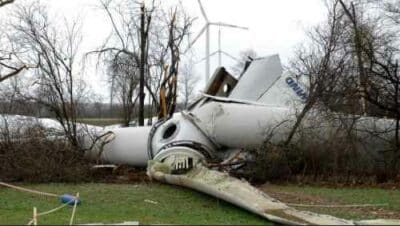A wind turbine in Sweden collapsed and is leaking oil everywhere. That’s right; they use oil – thousands of gallons of it. As Tom Elliott of Grabien writes on Twitter, “The best part of wind energy is the increased demand for oil.”
A wind turbine collapsed in Sweden recently and it came as a surprise to many Twitter users. As it happens, wind turbine accidents are not uncommon, windAction reports.
Depending on its size, a wind turbine gearbox needs an oil quantity between 200 (53 gallons) and 800 L (211 gallons), according to a peer-review article published by MDPI, titled “Monitoring the Oil of Wind-Turbine Gearboxes: Main Degradation Indicators and Detection Methods,” Craig Bannister writes at CNS News.
Patricia Pitsel, Ph.D., Principal at Pitsel & Associates Ltd., estimates that the typical wind farm requires about 12,000 gallons of oil:
“Right now, the average wind farm is about 150 turbines. Each wind turbine needs 80 gallons of oil as a lubricant, and we’re not talking about vegetable oil; this is a PAO synthetic oil based on crude… 12,000 gallons of it. That oil needs to be replaced once a year.
“It is estimated that a little over 3,800 turbines would be needed to power a city the size of New York… That’s 304,000 gallons of refined oil for just one city.”

Offshore wind turbines may generate green energy, but they use much more oil than proponents like to admit.
Just installing the foundation of a single offshore turbine can consume 18,857 barrels of marine fuel during construction, according to calculations published by Forbes. Offshore wind farms often have over 100 wind turbines, meaning that building them requires almost 2 million barrels of fuel to power the ships involved in construction.
You can’t even build a wind farm without oil.
According to Daily Caller News Foundation calculations, a wind farm’s power on offshore Long Island will cost around $25,000 for every home it powers.
Wind turbine companies claim they use half as much as natural gas, but reality suggests that is not true.
In Scotland, researchers say the payback takes more than a decade.
Aberdeen University researchers published in the Journal of Cleaner Production that concludes: ‘In the worst land-use change scenario, the data is comparable to the lifecycle emissions of fossil fuel technologies such as coal and gas-fired electricity generation.’ Garth Wind Farm on Yell, Shetland, began operating in 2017, but it will be at least 2028 before it stops being a net producer of carbon dioxide.
The university team found that 60 wind farms built on peatland produced as many CO₂-equivalent emissions as two million tons of coal.
Dr. Pitzel writes that each turbine requires a footprint of 1.5 acres, so a typical farm of 150 turbines needs 225 acres. To power New York City, you need 57,000 acres. Imagine having to cover the entire country. All the trees would have to go to get this land in proper shape.
In fairness, they are planning to move offshore. However, it’s cost prohibitive.
Some states aren’t even suitable for wind energy. They don’t work when the wind doesn’t blow or when it’s freezing. Look at what is going on in Texas.
The lifespan of a wind farm is 20 years, Dr. Pitzel adds. They cannot economically be reused, refurbished, reduced, repurposed, or recycled. So they go to landfills [with solar panels that experience the same problem].
Wind turbine blades kill about 500,000 birds yearly. Most dead birds are endangered hawks, falcons, owls, geese, ducks, and eagles.
Follow the money…
Real estimates of Wind Farms show a negative Retrun On Investment for Wind Farms when you factor in environmental impact, construction, and disposal cost. At least Solar Panels can have a ROI of about 20 years when you factor in Environment Impact. Remember both Wind and Solar require Batteries to store power for periods they’re not generating power. Lithium Batteries… Read more »
The oil consumption of a wind turbine is something of a red herring argument, at least to me. I am a realist, wind energy will never be a major contributor to the energy needs of the world as it exists today. The oil in the turbines is for lubrication, and is recirculated like the oil in your automobile’s engine. How… Read more »
Synthetic oil is not easily recycled and so does become an environmental issue. If True Environmental Impact Studies were required for “alternative energy” projects, most green energy farms would not be allowed.
Wind power should be researched, developed and implemented if needed by private industry only. We are in this mess because of government interference. It only meets cost and effectiveness standards in rare cases. You would fund a study which would go to leftist opportunists.
The democrats confuse political science with engineering science, just as they conflate weather with “climate change.”
Or conflate weather with chem trails.